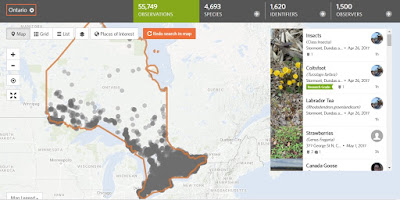But if you're like me, you occasionally look at things that don't have feathers and beaks. Seems like a shame to just let all of that great data go to waste. Over the years I have tried a number of other citizen science portals to report butterflies, moths, invasive species, reptiles and amphibians, bumblebees and more but I usually just got frustrated that the systems weren't as good as eBird and that I really didn't want to use ten different apps/programs.
I'm happy to say that I think I have settled on a universal program for all of my non-bird sightings - iNaturalst - and I hope you'll join me in adding your observations too. After all, these programs are more fun and provide better data as more people join in.
Since I bet most of you haven't used iNaturalist but are familiar with eBird I'll outline some of the differences and similarities between the two programs. eBird by far offers many superior features that are geared towards birders and will certainly continue to be the platform of choice for other birders and myself.
Checklist or record based? A really important thing to know going in to iNaturalist is that it is focused on individual records, not site checklists like eBird. The argument is that birders are really unique (perhaps along with "honorary birds" butterflies and dragonflies) in that they think about things in a site list kind of way, whereas most other naturalist think about things one record at a time. This works pretty well for iNaturalist but means it is very tedious if you want to enter a list of every species you observed at a site.
 |
| http://inaturalist.ca/observations/6005358 |
All species. iNaturalist takes records of ALL species. Yes, that means fungi, plants, birds, insects, etc....so far in Ontario there are reports of about 4700 species.
Don't have to know what you saw! iNaturalist lets you identify a record to any level. So, if you know it is an insect but no idea what kind, you can just report it as an insect. Someone will likely come along and suggest a higher identification for you.
Simple app. The app for iNaturalist is really simple to use, since you are submitting one record at a time you just take a photo and iNaturalist grabs the location and date/time...then all you have to do is enter your identification.
Uncertainty distance. This is a feature I always have wished for in eBird; in iNaturalist, each record has a location but also the uncertainty distance.
Location obscuring. You can manually obscure a location for a record to a 27 km area, or you can even set it as private; both of these options keep the detailed location of the record on file but other people will either see an obscured location or just the province, unless you give them permission by adding it to their project. All records of rare species are automatically obscured.
 |
| For rare species like this, the sighting is somewhere in this rectangle. The dot is the randomized coordinates displayed. |
Keeps all of your lists. Just like eBird, iNaturalist keeps lists for you - but unlike eBird these include all species and you can add to a list even if you don't have a record.
Community Review. This is a big difference from eBird and both a strength and weakness of iNaturalist. Review can be done by any iNaturalist user - just chime in and agree or offer an alternative ID of a record.
Places. In iNaturalist, places are defined with polygons - like eBird for Countries, States/Provinces, Counties, and IBAs. But in iNaturalist, anyone can create a place and define its boundaries. This is really handy because it lets you automatically collect all records that fall within that place.
Projects. This is a feature that eBird doesn't have (or need?) - it allows anyone to create a project which is basically a data aggregation tool. For example, you can have a bioblitz project to automatically collect records within a date/location or you can have a "standard" project like the NHIC's Rare Species of Ontario which collects records of provincially rare species (join it!).
Unlimited data fields. The bare minimum in iNaturalist is very simple, just date, location, and species but anyone can create a new data field and anyone else can add a value for it to an observation. Think things like insect life stage, breeding bird evidence, etc. It's very flexible if you want to track something in particular.
iNaturalist is by no means a perfect platform, but I think it is much better than any other system that takes records of all taxonomic groups out there. With the use of Projects, all of those other citizen science projects can grab your observations and add them to their databases. And, like eBird, it will only get better as more people use it.
By contributing your records to iNaturalist you're turning your observations into digital specimens making them available to inform our knowledge and contribute to conservation.
So please join the growing number of Ontario naturalists submitting to iNaturalist...let's make Ontario the powerhouse it is with eBird!
As always, I'm happy to help people if you have questions about getting started.







